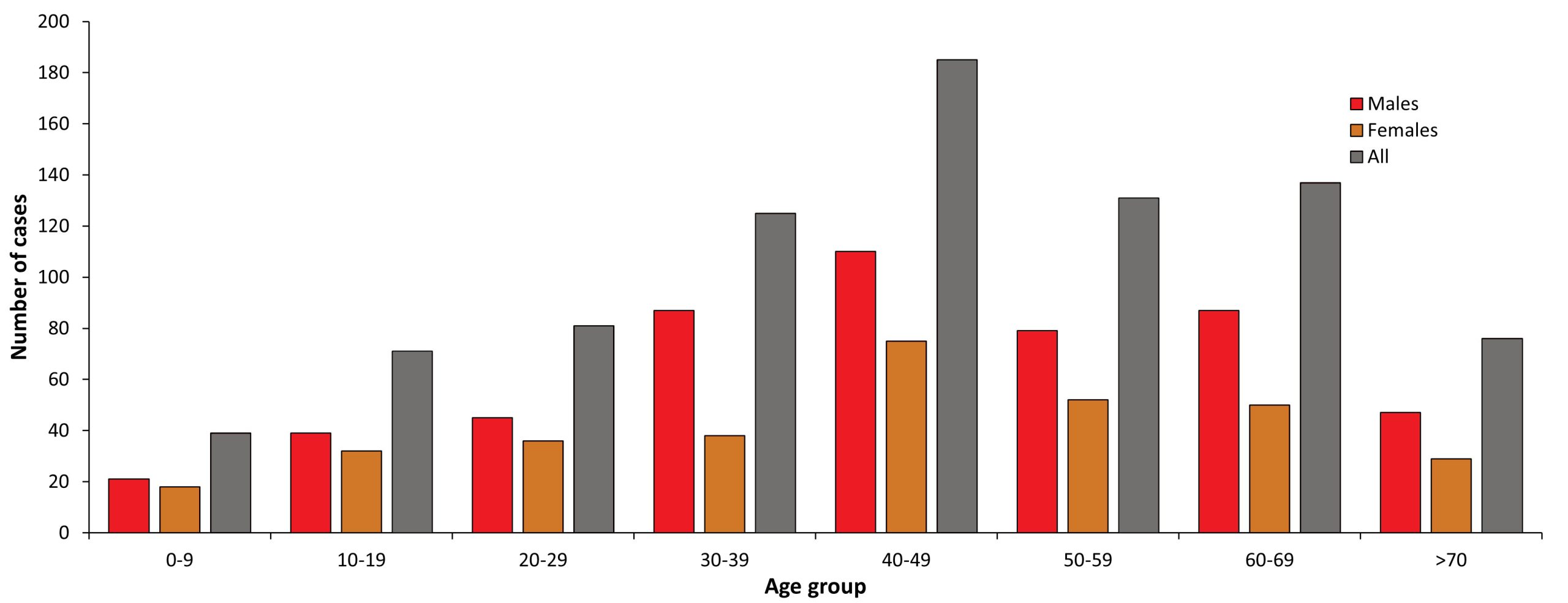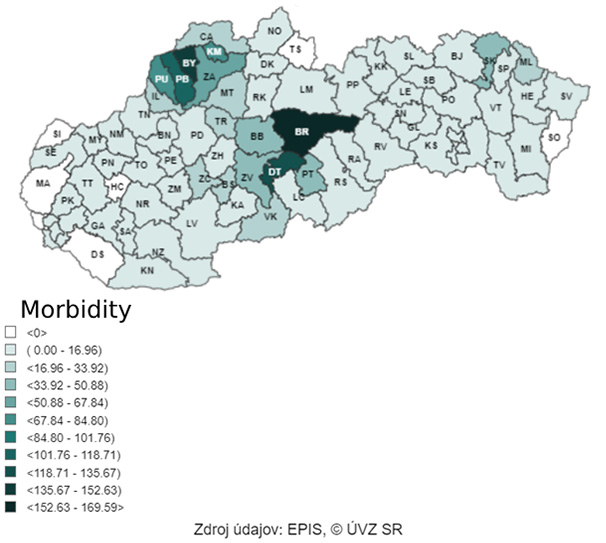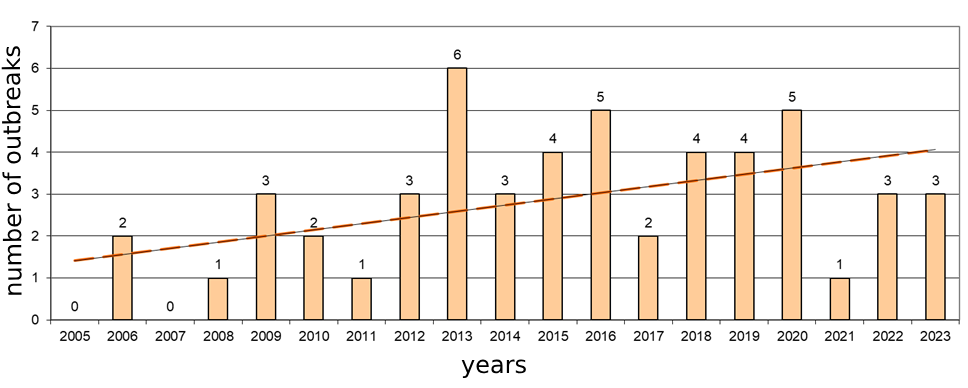Jana Kerlik
ECDC risk status: endemic
(last edited: date 26.03.2024)
History and current situation
The former Czechoslovak Republic was one of the first countries in Europe where the tick-borne encephalitis (TBE) virus was identified. This discovery was made in 1947, when Rampas and Gallia observed a high incidence of disease identified as “Czechoslovakia encephalitis”, and TBE virus was isolated from Ixodes ricinus.1
In 1951, for the first time ever, and again in Czechoslovakia, the alimentary transmission of TBE virus from infected animals to humans was confirmed during a large outbreak in Rožňava. There were 271 hospitalized and serologically confirmed TBE patients. Blaškovič et al. found that most patients had drunk milk from the local dairy, which did not comply with basic sanitary requirements. The milk had not been pasteurized, but only stirred, equalized, and distributed. In addition, the goat milk that had been supplied to the dairy was also possibly infected.2 During the examination of the TBE focus in Rožňava, the goats were found with high anti-TBE virus titers.3
A list of natural foci of TBE in Slovakia was developed by the Public Health Authority of Slovakia in 2002 directly on the basis of virus isolation data from ticks and reservoir animals in the years 1964–1997 from the Institute of Virology, Slovak Academy of Sciences in Bratislava as well as indirectly according to the site of infection in patients with TBE as reported during 1972–2002.8 In recent years there has been a shift of natural TBE foci from the southern to the northern and central areas of the country.9 The reason is attributed to several factors including climate change.4
There is a long-term increasing trend of TBE cases in Slovakia. In 2022 we observed the highest number of TBE cases over the last 60 years.31
Slovakia is well known in Europe for TBE alimentary outbreaks that are reported almost every year.10 Over the last few years, there has been a growing trend in the number of food-borne TBE outbreaks. The percentage of TBE virus infections through consumption of unpasteurized milk and its products is quite high compared with other countries, e. g. in 2023, 34% of alimentary TBE cases were reported.31 Slovaks like to consume traditional products made from raw goat and sheep milk, especially sheep cheese. Moreover, raw goat milk has been recently promoted as a product to improve health and immunity in humans.
In 2020 we reported a case of probable transmission of TBE virus from an unvaccinated mother to an infant through breast-feeding.5
Overview of TBE in Slovakia
| Table 1: TBE in Slovakia | |
|---|---|
| Viral subtypes isolated | European subtype1 |
| Reservoir animals | Tribeč region (Jarok pri Nitre, Jelenec, Topoľčianky), 1965: Out of 46 blood and brain samples taken from moles (Talpa europaea), 7 positive isolations of TBE VIRUS were obtained. Therefore, moles can represent not only an important host animal, but may also be considered a reservoir of TBE VIRUS in elementary foci11 Tribeč region, 1967: Isolation of virus from the blood of Apodemus flavicollis, Clethrionomys glareolus, and Erinaceus roumanicus12 Tribeč region, 1967: 2 TBE VIRUS strains were isolated from Ixodes ricinus collected on 2 Turdus merula13 Lúky pod Makytou, 1981: 5 strains of TBE VIRUS isolated from ticks and organs of Apodemus flavicollis (in 15% infected)14 Western Slovakia (6 localities), 1981–1986: 6 TBE VIRUS strains isolated from organs of C. glareolus (4), Apodemus flavicollis (1), Sorex araneus (1)15 Záhorská Ves, 1990–1992: 8 TBE virus isolates from organs of C. glareolus (6), Apodemus flavicollis (1), Apodemus sylvaticus (1)16 Košická Belá, 2013: TBE virus from the brain sample of Buteo buteo17 The Drienovská wetland, 2019-2020: 9.8% seropositivity in the birds (n = 37) of 376 tested sera28 |
| Percentage infected ticks | The number of infected ticks in endemic areas varies widely from 0.1% to 5% depending on the season and habitat18 Tribeč, 1964: On average, 0.2% of ticks were infected by TBE virus in the entire Tribeč region. When only elementary foci were taken into account, this proportion increased to 0.4% (Topoľčianky) and 0.8% (Jelenec)18 Záhorská Bystrica, 1965: 1.7% of female ticks infected by TBE virus19 Devín, 1973: 0.1% of nymphs and 1.1% of female ticks infected by TBE virus20 Slovakia, 1981: In Slovakia there are 2 types of TBE VIRUS natural foci – Carpathian and Pannonian. In Carpathian natural TBE virus foci, there were 2.6% of ticks infected by TBE virus. In the Pannonian natural TBE virus foci, there were 0.1% of ticks infected by TBE virus21 Kurínec, 1982: 0.8% of nymphs and 6% of male ticks (I. ricinus) in south-central Slovakia22 Carpathian and Pannonian types of TBE natural foci, 1972–1982: The proportion of infected ticks in both types of natural foci was 1.7% in total. In Carpathian elementary foci (ranging from 0.4% to 4.1%; average of 2.5% of ticks were infected). In Pannonian elementary foci (ranging from 0.07% to 6.0%; average of 0.9% of ticks were infected)23 Western and Central Slovakia, 1980–1984: Western Slovakia, April–July 1980 (0.7%), May 1984 (0.1%), Central Slovakia April–May 1982 (0.2%)24 Western Slovakia, 1985–1990: In Slovakia surveillance of TBE virus in ticks, carried out during 1985–1990 by the Virology Institute of the Slovak Academy of Sciences in Bratislava, showed that the TBE virus distribution rates among ticks ranged from 0.30% (Jarok, Bardoňovo in 1987) to 0.38% (Malacky in 1990) in the 25 sites in the western region (data not published) Žiar nad Hronom, Banská Štiavnica a Žarnovica, 2002–2007: In the small sample of 142 ticks tested, there were 4.98% infected with TBE virus25 |
| Dairy product transmission | Slovakia is well known in Europe for TBE alimentary outbreaks that are reported almost every year.10 Over the few last years, there has been a growing trend in the number of food-borne TBE outbreaks. The percentage of TBE virus infection through consumption of unpasteurized milk and its products is quite high compared with other countries, e. g. in 2023, 34% of alimentary TBE cases were reported.31 During 2007–2016 a total of 26 TBE alimentary outbreaks (2 or more cases/outbreak) with 142 TBE cases have been observed (13.9% of all TBE cases). Larger outbreaks with 3 or more cases have been recorded 13 times. The most common transmission factor of TBE virus during outbreaks has been goat milk and its products (61.5%, 16 outbreaks). Sheep’s milk and products have caused probably 7 outbreaks (26.9%) and cow’s milk was the probable cause of 2 TBE outbreaks (7.7%). In one TBE outbreak, the probable TBE transmission factor was reported to be mixed goat and sheep milk.10 In the majority of outbreaks (22) the probable transmission factor of TBE virus was identified epidemiologically. In 2016 a TBE outbreak with the highest number of TBE cases (44) over the past 30 years was reported in Eastern Slovakia, sheep cheese was considered as TBE virus transmission factor by retrospective case control study.26 In 2023 a TBE outbreak with 28 cases was reported in Central Slovakia. Sheep cheese was considered as the probable TBE virus transmission factor.31 |
| Case definition used by authorities | Based on ECDC, 201827 |
| Completeness of case detection and reporting | No valid data to estimate the percentage of undetected and underreported cases. |
| Type of reporting | Mandatory |
| Other TBE-surveillance | No |
| Special clinical features | Sequelae 52% (after 3 years)30 |
| Licensed vaccines | FSME-Immun since 1995; FSME-Immun Junior since 2005 |
| Vaccination recommendations | According to Decree No 585/2008 Coll. of the Ministry of Health of the Slovak Republic, which defines details on prevention and control of communicable diseases, TBE vaccination is compulsory for employees of virological laboratories working with TBE virus and TBE vaccination is recommended for occupationally exposed persons (forest workers, students of forestry schools, agriculture workers, etc.). Insurance companies partially reimburse TBE vaccine in Slovakia.6,7 |
| Vaccine uptake | 20% for 2 or more TBE vaccine doses (general population, survey)29 |
| National Reference center for TBE | National Reference Centre for Arboviruses and Haemorrhagic fevers Dr. Elena Tichá Public Health Authority of Slovakia Trnavská cesta 52 826 45 Bratislava Slovakia elena.ticha@uvzsr.sk |
Figure 1: Burden of TBE in Slovakia over time; trend of TBE in Slovakia, 2014-20231

| Year | Number of cases | Incidence / 105 |
|---|---|---|
| 1952 | 52 | 1.5 |
| 1953 | 267 | 7.4 |
| 1954 | 241 | 6.6 |
| 1955 | 343 | 92 |
| 1956 | 121 | 3.2 |
| 1957 | 84 | 2.2 |
| 1958 | 110 | 2.8 |
| 1959 | 110 | 2.8 |
| 1960 | 217 | 5.4 |
| 1961 | 57 | 1.4 |
| 1962 | 88 | 2.1 |
| 1963 | 92 | 2.1 |
| 1964 | 16 | 0.4 |
| 1965 | 30 | 0.7 |
| 1966 | 13 | 0.3 |
| 1967 | not available | not available |
| 1968 | 5 | 0.1 |
| 1969 | 6 | 0.1 |
| 1970 | 7 | 0.2 |
| 1971 | 4 | 0.1 |
| 1972 | 15 | 0.3 |
| 1973 | 15 | 0.3 |
| 1974 | 33 | 0.7 |
| 1975 | 32 | 0.7 |
| 1976 | 22 | 0.5 |
| 1977 | 15 | 0.3 |
| 1978 | 34 | 0.7 |
| 1979 | 49 | 1 |
| 1980 | 20 | 0.4 |
| 1981 | 25 | 0.5 |
| 1982 | 48 | 1 |
| 1983 | 34 | 0.7 |
| 1984 | 78 | 1.5 |
| 1985 | 36 | 0.7 |
| 1986 | 21 | 0.4 |
| 1987 | 24 | 0.5 |
| 1988 | 29 | 0.6 |
| 1989 | 18 | 0.3 |
| 1990 | 14 | 0.3 |
| 1991 | 24 | 0.5 |
| 1992 | 16 | 0.3 |
| 1993 | 51 | 1.07 |
| 1994 | 60 | 1.1 |
| 1995 | 89 | 1.6 |
| 1996 | 82 | 1.5 |
| 1997 | 76 | 1.4 |
| 1998 | 54 | 1 |
| 1999 | 63 | 1.17 |
| 2000 | 92 | 1.71 |
| 2001 | 75 | 1.39 |
| 2002 | 62 | 1.15 |
| 2003 | 74 | 1.38 |
| 2004 | 50 | 0.93 |
| 2005 | 50 | 0.93 |
| 2006 | 91 | 1.69 |
| 2007 | 57 | 1.06 |
| 2008 | 79 | 1.46 |
| 2009 | 76 | 1.4 |
| 2010 | 90 | 1.66 |
| 2011 | 108 | 1.99 |
| 2012 | 107 | 1.98 |
| 2013 | 162 | 2.99 |
| 2014 | 117 | 2.16 |
| 2015 | 88 | 1.62 |
| 2016 | 174 | 3.21 |
| 2017 | 75 | 1.38 |
| 2018 | 156 | 2.87 |
| 2019 | 161* | 2.95 |
| 2020 | 185** | 3.39 |
| 2021 | 96*** | 1.76 |
| 2022 | 203**** | 3.74 |
| 2023 | 200 | 3.68 |
1952–1996: Grešíková M. [Tick-borne encephalitis – permanent public health problem]. VEDA Bratislava 1999, p 62. [Monograph in Slovak].
1997–2022: [Epidemiologický informačný systém] [Internet] Epidemiological Information System; 2022 [Cited 2023 Feb 20]. Data export 2006–2022. Available at: www.epis.sk [In Slovak].
There were 161 TBE cases in 2019. There were 4 alimentary outbreaks:
Figure 2: Age and gender distribution of TBE in Slovakia, 2019-2023

| Age group | Males | Females | All |
|---|---|---|---|
| 0-9 | 21 | 18 | 39 |
| 10-19 | 39 | 32 | 71 |
| 20-29 | 45 | 36 | 81 |
| 30-39 | 87 | 38 | 125 |
| 40-49 | 110 | 75 | 185 |
| 50-59 | 79 | 52 | 131 |
| 60-69 | 87 | 50 | 137 |
| >70 | 47 | 29 | 76 |
[Epidemiologický informačný systém] [Internet] Epidemiological Information System; 2017 [Cited 2017 Jan 5]. Data export 2015. Available at: www.epis.sk [In Slovak].
Contact
Jana Kerlik
jana.kerlik@vzbb.sk
Author
Citation
Kerlik J. TBE in Slovakia. Chapter 13. In: Dobler G, Erber W, Bröker M, Chitimia-Dobler L, Schmitt HJ, eds. The TBE Book. 7th ed. Singapore: Global Health Press; 2024. doi:10.33442/26613980_13-29-7
References
- Rampas J, Gallia F. [Isolation of tick-borne encephalitis virus from ticks Ixodes ricinus]. Čas Lék Čes. 1949;88:1179-80.
- Blaškovič D. [Outbreak of encephalitis in Rožňava natural focus of infections]. Bratislava: VEDA SAV, 1954. 314 p.
- Bárdoš V, Hanzal F, Havlík O, et al. [Csechoslovak tick-borne encephalitis]. Praha: Státní zdravotnické nakladatelství, 1954. 92 p.
- Dorko E, Rimárová K, Kizek P, Stebnický M, Zákutná L. Increasing incidence of tick-borne encephalitis and its importance in the Slovak Republic. Cent Eur J Public Health. 2014;22(4):277-281. doi:10.21101/cejph.a3939.
- Kerlik J, Avdičová M, Musilová M, Bérešová J, Mezencev R. Breast Milk as Route of Tick-Borne Encephalitis Virus Transmission from Mother to Infant. Emerg Infect Dis. 2022;28(5):1060-1061. doi:10.3201/eid2805.212457
- [Decree No. 585/2008 Coll. of the Ministry of Health of the Slovak Republic, which defines details on prevention and control of communicable diseases]. Zbierka zákonov SR. 2008 Dec 10;Pt 202:5024-41.
- [Criteria for submission of the contribution for the payment of the vaccine against TBE]. Dôvera; 2024. Accessed March 5, 2024. https://www.dovera.sk/poistenec/potrebujem-poradit/vyhody-pre-poistencov/kriteria-na-poskytnutie-prispevku-na-uhradu-vakciny-proti-kliestovej-encefalitide.
- [Natural foci of tick-borne encephalitis in Slovakia] Public Health Authority of Slovak Republic; 2017. Accessed 9 January, 2017. https://www.uvzsr.sk/index.php?option=com_content&view=article&id=395:prirodne-ohniska- klieovej-encefalitidy-na-slovensku&catid=68:epidemiologia&Itemid=76.
- Lukan M, Bullova E, Petko B. Climate warming and tick-borne encephalitis, Slovakia. Emerg Infect Dis. 2010;16(3):524-526. doi:10.3201/eid1603.081364
- Kerlik J, Avdičová M, Štefkovičová M, et al. Slovakia reports highest occurrence of alimentary tick-borne encephalitis in Europe: Analysis of tick-borne encephalitis outbreaks in Slovakia during 2007-2016. Travel Med Infect Dis. 2018;26:37-42. doi:10.1016/j.tmaid.2018.07.001
- Kozuch O, Grulich I, Nosek J. Serological survey and isolation of tick-borne encephalitis virus from the blood of the mole (Talpa europaea) in a natural focus. Acta Virol. 1966;10:557-60.
- Kozuch O, Gresíková M, Nosek J, Lichard M, Sekeyová M. The role of small rodents and hedgehogs in a natural focus of tick-borne encephalitis. Bull World Health Organ. 1967;36 Suppl(Suppl 1):61-66.
- Ernek E, Kozuch O, Lichard M, Nosek J. The role of birds in the circulation of tick-borne encephalitis virus in the Tribec region. Acta Virol. 1968;12:468-70.
- Nosek J, Kožuch O, Grešíková M, et al. [Uncovering natural foci of tick-borne encephalitis in Central Slovakia]. II. Synecology of tick-borne encephalitis virus in Central river Váh area. Bratisl Lek listy. 1982;77:257-63.
- Kozuch O, Labuda M, Lysý J, Weismann P, Krippel E. Longitudinal study of natural foci of Central European encephalitis virus in West Slovakia. Acta Virol. 1990;34:537-44.
- Kožuch O, Guryčová D, Lysý J, Labuda M. Mixed natural focus of tick-borne encephalitis, tularemia and haemorrhagic fever with renal syndrome in west Slovakia. Acta Virol. 1995;39:95- 8.
- Csank T, Bhide K, Bencúrová E, et al. Detection of West Nile virus and tick-borne encephalitis virus in birds in lovakia, using a universal primer set. Arch Virol. 2016;161:1679-83. doi:10.1007/s00705-016-2828-5
- Grešíková M, Nosek J. Isolation of Tick-borne Encephalitis Virus from Ixodes ricinus Ticks in the Tribec region. Bull World Health Organ. 1967;36(Supp 67-71).
- Grešíková M, Kožuch O, Nosek J. Die rolle von Ixodes ricinus als Vektor des Zeckenencephalitis Virus in verschiedenen mitteleuropäischen Naturherden [The role of Ixodes ricinus as vector of tick-borne encephalitis virus in different Central European natural foci]. Zentralbl Bakteriol Orig. 1968;207(4):423-429.
- Grešíková M. [Isolation of tick-borne encephalitis strains Bratislava from ticks Ixodes ricinus collected by Devin pathway]. Bratisl Lek Listy. 1975;64:1-128.
- Grešíková M. [Tick-borne encephalitis – permanent public health problem]. VEDA Bratislava. 1999, p 62.
- Grešíková M, Palanová A, Pötheová A, Teplan J, Sekezová M, Kohutová V. [Contribution to harnessing natural foci of tick- borne encephalitis in the south central Slovakia]. Bratisl Lek Listy. 1983;80:385-512.
- Gresíková M, Kozuch O, Sekeyová M, Nosek J. Studies on the ecology of tick-borne encephalitis virus in the Carpathian and Pannonian types of natural foci. Acta Virol. 1986;30:325-31.
- Grešíková M, Sláčiková M, Kožuch O. Tick-borne encephalitis in Slovakia during years 1980-1984. Bratisl Lek Listy. 1987;88:358-65.
- Košťanová Z. We searched for one, we discovered more and what’s next? Zoonoses – Protection of public and animal health reviewed abstracts from the 5th scientific congress. Slovak Medical University, Bratislava, 2016. 322 p. https://www.sevs.sls.sk/images/public/Reviewed_Abstracts_Zoonoses_2016.pdf
- Tarkovská V, Seligová J, Molčányi T. [Tick-borne encephalitis outbreak with alimentary transmission in district Košice surrounding in 2016]. Collection of abstracts XXII. Červenka days, 2017;p. 17.
- Commission Implementing Decision (EU) 2018/945 of 22 June 2018 on the communicable diseases and related special health issues to be covered by epidemiological surveillance as well as relevant case definitions. Accessed 25 March, 2024. https://eur-lex.europa.eu/legal-content/EN/TXT/PDF/?uri=CELEX:32018D0945.
- Peňazziová, K.; Korytár, Ľ.; Cingeľová Maruščáková, I.; Schusterová, P.; Loziak, A.; Pivka, S.; Ondrejková, A.; Pistl, J.; Csank, T. Serologic Investigation on Tick-Borne Encephalitis Virus, Kemerovo Virus and Tribeč Virus Infections in Wild Birds. Microorganisms. 2022;10(12):2397. Published 2022 Dec 2. doi:10.3390/microorganisms10122397
- Pilz A, Erber W, Schmitt HJ. Vaccine uptake in 20 countries in Europe 2020: Focus on tick-borne encephalitis (TBE). Ticks Tick Borne Dis. 2023;14(1):102059. doi:10.1016/j.ttbdis.2022.102059
- Paraličová Z, Sekula J, Jarčuška P, et al. Outbreak of Alimentary Tick-Borne Encephalitis in Eastern Slovakia: An Analysis of Affected Patients and Long-Term Outcomes. Pathogens. 2022;11(4):433. Published 2022 Apr 2. doi:10.3390/pathogens11040433
- Public Health Authority of Slovak Republic. Epidemiological Information system.

